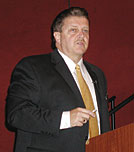
Take "Operation and Maintenance of Centrifugal Chillers for Maximum Efficiency," a seminar held during this year's Annual Meeting in Denver. The first speaker, John Vucci, spoke about "Chiller Maintenance, the Never-Ending Story." Vucci is an associate director of HVAC systems at the University of Maryland, College Park, Md., and a former service manager with Poole & Kent.
His "whirlwind slide show" focused on smaller plants of 40 to 60 tons. "Small plants need to be considered like larger ones," he said.
The title of his seminar, he explained, came from his experience with maintenance budgeting.
"The guys are always coming to me, wanting new tools and stuff to perform maintenance. It's never-ending."
Vucci briefly compared proactive, scheduled maintenance with reactive maintenance, describing the latter as "running equipment until it breaks, then replacing it."
Scheduled refrigerant-side maintenance could include:
Regular service/maintenance should also include making sure the evaporator is maintaining heat transfer, and upgrading refrigeration systems, specifically changing over to spring-loaded relief valves.
Hybrid Maintenance
One system in Vucci's history was a 21-ton hybrid steam-electric chiller (125-psig steam and 480-VAC electric). His crew regularly performed condenser and closed-loop maintenance. "You can get fouling or closed-loop corrosion unless the system is tested on startup," he said.Mechanical room ventilation is another vital consideration, Vucci said. "There is a refrigerant-specific monitor, and the refrigerant monitor's pickup tube filter gets dirty," affecting its accuracy. His crew also performed switchgear testing per NFPE requirements.
To maintain a system's heat transfer efficiency, the crew would "rod the condensers" once a year, minimum. Removing condenser heads for cleaning is extremely important but also difficult because of their size - about 1,500 pounds, Vucci said. "It's too heavy for one person. Or is it?"
To clean these heads, Vucci's crew installed rigging to lift and move condenser heads. The rigging makes it "practically a one-man job."
After the cleaning is finished, maintenance staff would paint tube sheets with an epoxy coating.
For cooling towers, Vucci recommended annual cleaning at the end of the cooling season, and flushing out debris at startup. "Cooling towers are great air-wash devices," he quipped. In addition, check the operation of tower level and fan controls.
For condenser pumps, make sure strainers are cleaned annually. "Evaporator pumps require plant control maintenance and checks to tolerances."
Mechanical starters and variable-speed drives should be inspected and cleaned, blowing out debris and vacuuming the cabinets.

Seven Ways To Love Your Chiller
Ian Spanowick, a product manager with York International, York, Pa., offered his audience "Seven Methods for Improving Chiller Performance.""The chiller specifically offers opportunities to improve performance," Spanowick said.
Getting a baseline of the system's operation underpins the entire process, he pointed out. Taking those baseline operational measurements for an existing plant can point out the biggest opportunities to save money. "If you're going to juice the overall performance of a building, the chiller is the place to start." Tracking performance also shows potential problems.
Spanowick described the seven things to look at as follows:
1. Temperature reset - 99 percent of the chiller's operation will be at off-design conditions. "Chilled-water temperature doesn't need to be as cold," he said. "Drop the delta T, lower the condenser water temperature" while making sure the setpoint is at the manufacturer's minimum. Doing this helps reduce head pressure on the chiller.
2. Convert to variable-primary-flow pumping systems. "This saves on chilled water pump power but requires a few more components," Spanowick said. "It needs good chiller control and sequencing."
3. Add a variable-speed drive for increased efficiency at off-design conditions. It also soft starts the chiller.
4. Modernize the chiller controls. This offers multiple benefits, such as better response to load changes and better temperature control. Trending screens can help identify maintenance needs.
5. Add a chiller plant automation control (energy management, demand limiting, chilled-water reset). This offers time-of-day start-stop operation and can provide maintenance red flags.
6. Retrofit with a new motor compressor and possibly a new heat transfer surface. Change out mechanical components that are causing problems, and, if needed, perform a refrigerant conversion.
7. Replacing the entire chiller is "the ultimate change" Spanowick said. However, you need to justify payback.
Publication date: 08/08/2005

Report Abusive Comment